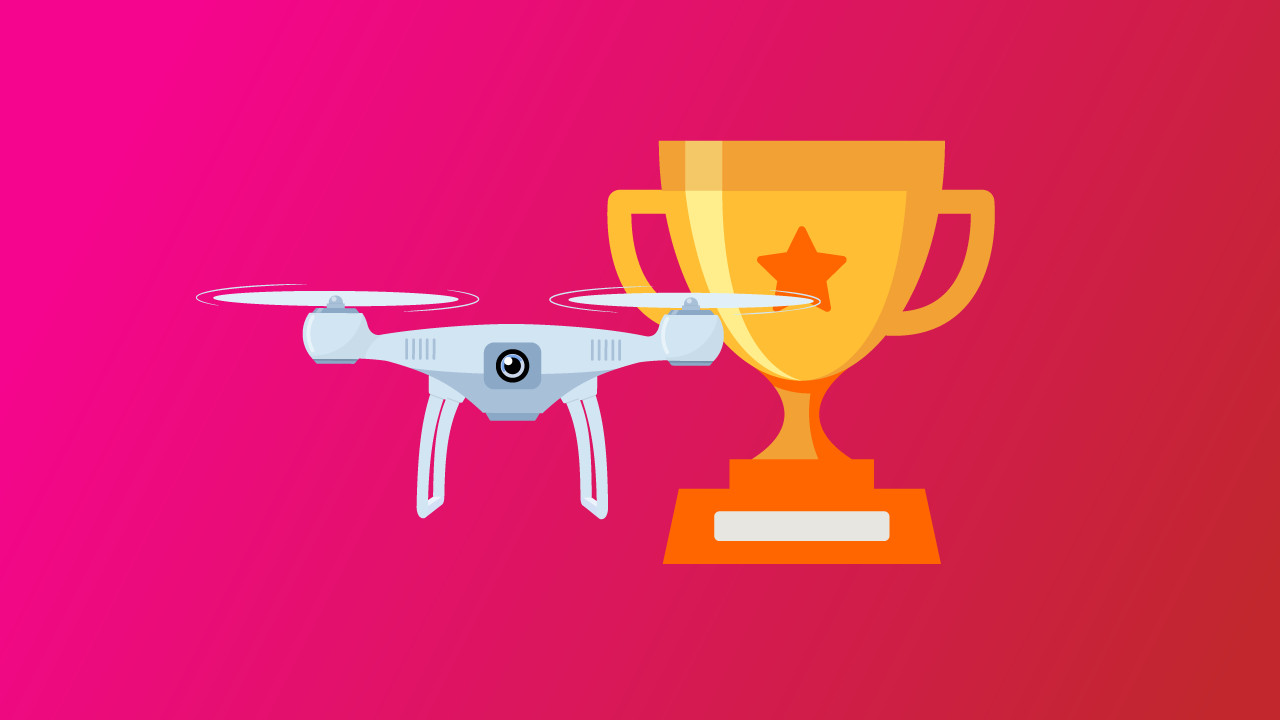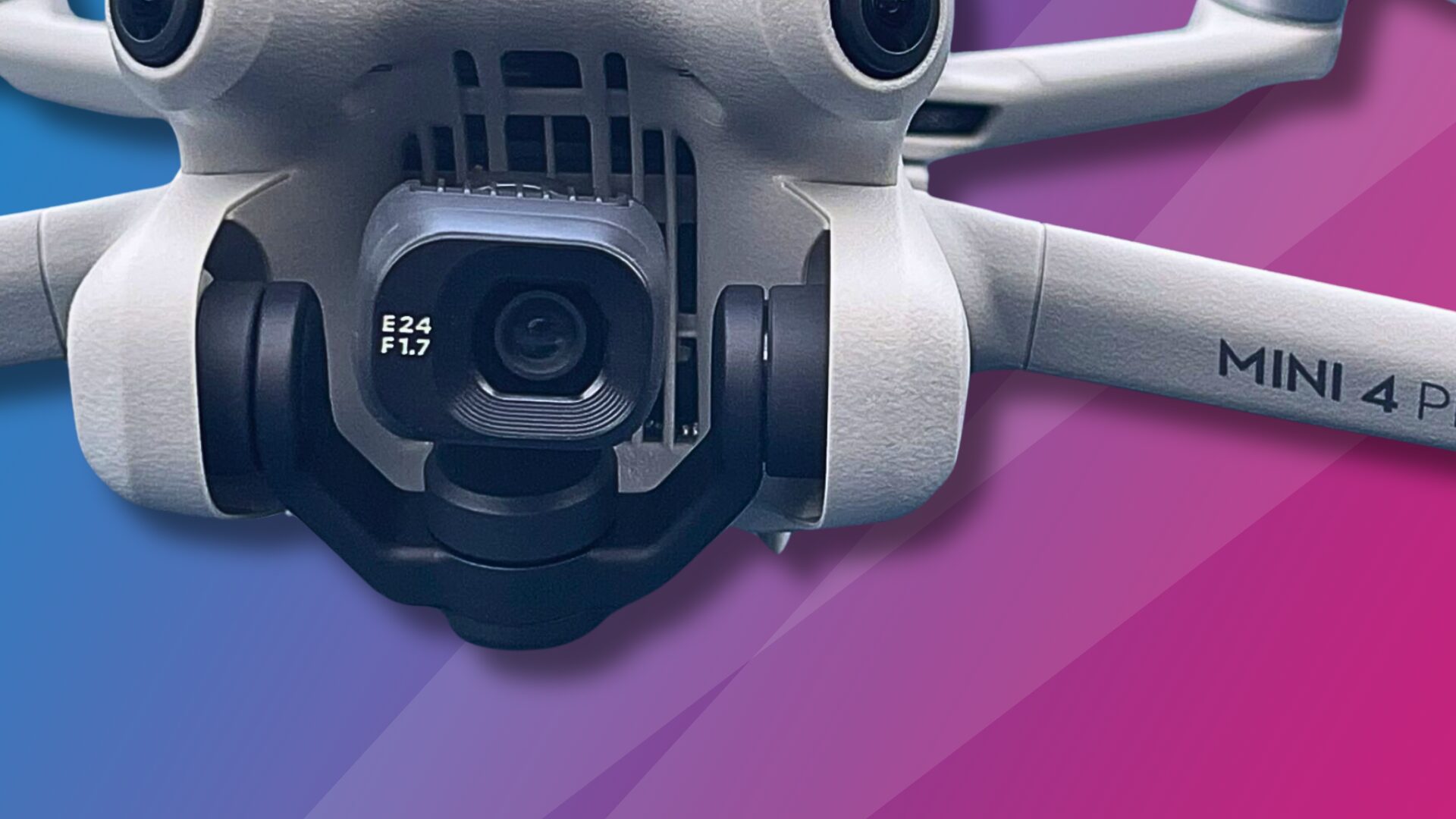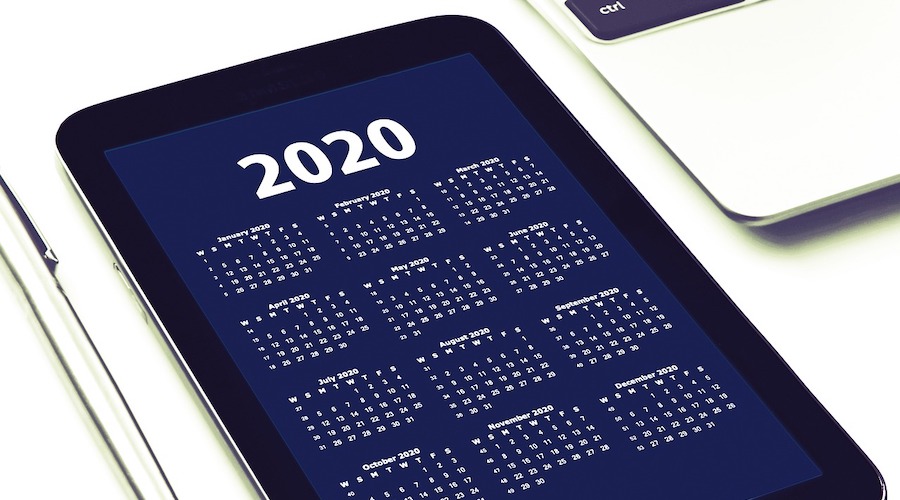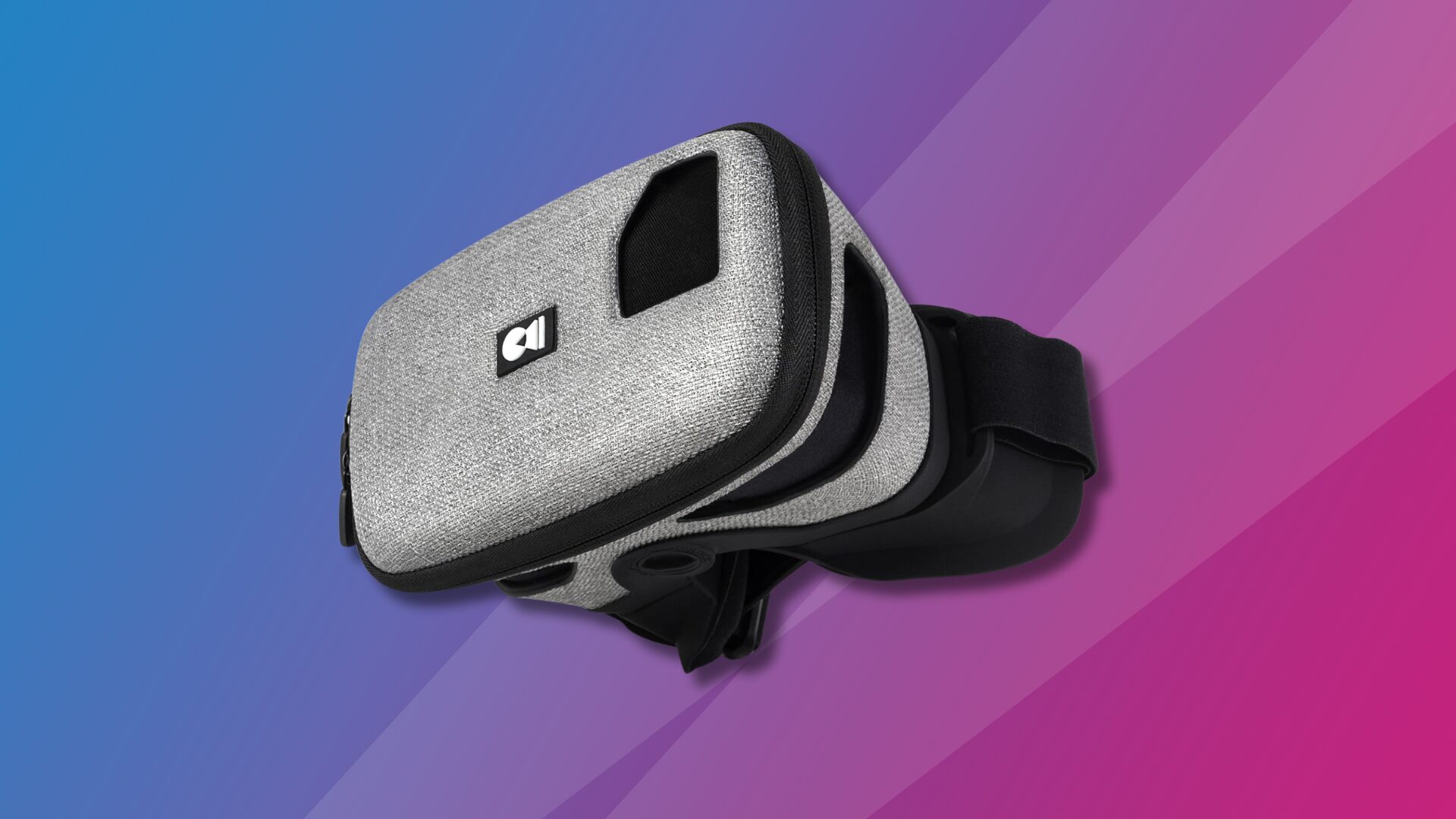-
Key Takeaways
-
Best Consumer Drones Comparison Table: Specs and Features Overview
-
Ranking the Best Consumer Drones
-
1. DJI Mini 4 Pro
- Best Compact Drone for Beginners and Travelers
- Pros:
- Cons:
-
2. DJI Air 3S
- Best Mid-Range Drone for Creative Shooters
- Pros:
- Cons:
-
3. DJI Mavic 4 Pro
- Best Premium Drone for Professional Photography
- Pros:
- Cons:
-
4. Autel EVO II Pro V3
- Best DJI Alternative with Pro Specs
- Pros:
- Cons:
-
5. HoverAir X1 ProMax
- Best Autonomous Selfie Drone
- Pros:
- Cons:
-
6. Parrot Anafi USA
- Best Thermal Drone for Industrial & Public Safety Use
- Pros:
- Cons:
-
7. DJI FPV
- Best Entry-Level FPV Drone for Freestyle
- Pros:
- Cons:
-
8. DJI Avata 2
- Best FPV Drone for Cinematic Shots
- Pros:
- Cons:
-
9. DJI Neo
- Best Beginner Drone Under $200
- Pros:
- Cons:
-
10. Holy Stone HS720E
- Best Budget Drone with 4K and GPS
- Pros:
- Cons:
-
11. EXO Scout
- Best Entry-Level Drone with Voice Commands
- Pros:
- Cons:
-
How to Decide Which Drone to Buy
- Define Your Primary Use Case
- Set Your Budget Range
- Think About Flight Time and Battery Life
- Camera Quality vs Portability
- Do You Want Beginner-Friendly Features?
- Regulations: Do You Need to Register It?
-
DJI Drone Considerations
- Why DJI Dominates the Drone Market
- Key Differences Between DJI Models
- DJI Geofencing: What You Should Know
- What’s Going On With the DJI Ban in the U.S.?
- Alternatives to DJI: Are They Worth It?
-
Conclusion
So, you’re ready to buy a drone. In a market flooded with dazzling specs and flashy marketing, how do you know which one is worth your hard-earned dollars?
From the pocket-sized HoverAir X1 ProMax to the powerhouse DJI Mavic 4 Pro featuring jaw-dropping video capabilities, the options can be overwhelming.
This guide helps cut through the noise, offering a real, ranked comparison to help you identify the consumer model best suited to your needs.
Key Takeaways
- The DJI Mini 4 Pro tops the list with a compact, feature-packed design at an affordable price point.
- Several DJI models make our top favorites, from the professional Mavic 4 Pro to the FPV Avata 2.
- The best option for travelers and action enthusiasts is the HoverAir X1 ProMax, featuring stunning 8K video.
- Social media content creators and vloggers will love the DJ Neo with its innovative features, like vertical video and built-in Glamour Effects.
- The Holy Stone HS720E and EXO Scout round out the list as some of the best budget options for beginners.
Best Consumer Drones Comparison Table: Specs and Features Overview
Only got a minute? Check out this side-by-side comparison of our best consumer drones for 2025, listing key specs buyers care about: flight time, camera and video capabilities, use case, and price points.
| Drone Model | Flight Time | Camera | Max Video Res | Use Case | Price (USD) |
| DJI Mini 4 Pro | 34 Minutes Average, up to 45 minutes | 1/1.3” CMOS for 48 – 50 MP | 4K/ 60 fps HDR/ 4K/100 fps Slow Motion | Hobbyists, Travel Content Creators | $759-$1,159 |
| DJI Air 3S | 45 Minutes | Primary 1-inch CMOS Capable of 50 MP, with a Secondary 70mm Telephoto Lens | 4K/ 120 fps | Travel Content Creators, Photographers, Intermediate and Professional Pilots | $1,099-$1,599 |
| DJI Mavic 4 Pro | 51 Minutes | Wide Hasselblad 4/3” CMOS shoots 100 MP, with second and third cameras offering 48 and 50 MP | 4K at 120 fps, 6K at 60 fps | Advanced Photographers and Videographers | $2,699 – $4,649 |
| Autel EVO II Pro V3 | 40 Minutes | 1-inch CMOS for 20 MP | 6K at 30 fps | Hobbyists, Photographers, and Videographers | $2,099 |
| HoverAir X1 ProMax | 16 Minutes | 1/1.3” CMOS for up to 48 MP | 8K at 30 fps | Social Media Content Creators, Travel Content Creators, Sports Enthusiasts | $955 – $1,282 |
| Parrot Anafi USA | 32 Minutes | 21 MP with Rectilinear and Thermal Secondary Cameras | 4K at 30 fps | Industrial Inspectors, Public Safety, and Law Enforcement Applications | $7,000 |
| DJI FPV | 16 Minutes | ⅓.2 “CMOS for 12 MP | 4K at 60 fps | FPV Racers, Beginner FPV Pilots | $679 – $1,500 |
| DJI Avata 2 | 23 Minutes | 1/1.3” CMOS for 48 MP | 4K at 60 fps | Travel Content Creators, Intermediate and Advanced FPV Pilots | $549 – $829 |
| DJI Neo | 18 Minutes | ½” inch sensor for 12 MP | 4K at 30 fps | Vloggers, Social Media Content Creators, and Beginner Pilots | $199 |
| Holy Stone HS720E | 46 Minutes | 12 MP | 4K at 30 fps | Beginner Pilots and Those on a Budget | $299 – $409 |
| EXO Scout | 18 Minutes | 6 MP | 1080p | Beginner Pilots and Those on a Budget | $129.99 |
Ranking the Best Consumer Drones
Now, time for a bit more of a deep dive. Each drone on our list has been evaluated based on performance, price, and key features. Whether you are new to drones or upgrading your current setup, this list helps you find the right match.
1. DJI Mini 4 Pro

Best Compact Drone for Beginners and Travelers
The DJI Mini 4 Pro is a compact, yet innovative drone that offers pilots advanced imaging capabilities with impressive flight modes. The DJI Mini 4 Pro is ideal for hobbyists or traveling content creators with its foldable, lightweight design and vertical shooting options for capturing high-quality content on the go.
| Key Specs | Details |
| Max Flight Time | 45 Minutes (Advertised), ~34 Minutes (User Average) |
| Camera Resolution | 48 MP |
| Max Video Resolution | 4K at 60 fps HDR, 4K at 100 fps Slow Motion |
| Sensor Type | 1/1.3” CMOS Sensor with f/1.7 Aperture |
| Obstacle Avoidance | Omnidirectional Sensors with Infrared Enhancement |
| Transmission Range | 12.4 Miles (20 km) |
| Weight | 249 g |
| Flight Modes | ActiveTrack 360º, QuickShots, Waypoint Flight, Hyperlapse |
| Price | $759 ($1,159 with Fly More Combo + RC) |
| Manufacturing Location | China |
Pros:
- No FAA registration needed for recreational use under 250 g. Required for commercial flights.
- Extended battery life with the Intelligent Battery Plus.
- 4K/ 60 fps vertical shooting.
- Shoots video in 10-bit D-Log M for impressive post-production color grading.
- 48MP stills in RAW.
Cons:
- Uses digital zoom only.
- Real-world flight time is often less than advertised.
- Issues with shipping and customs–buyers have faced long shipping times and rejection of orders at customs.
- Security concerns limit use in federal government agencies.
2. DJI Air 3S
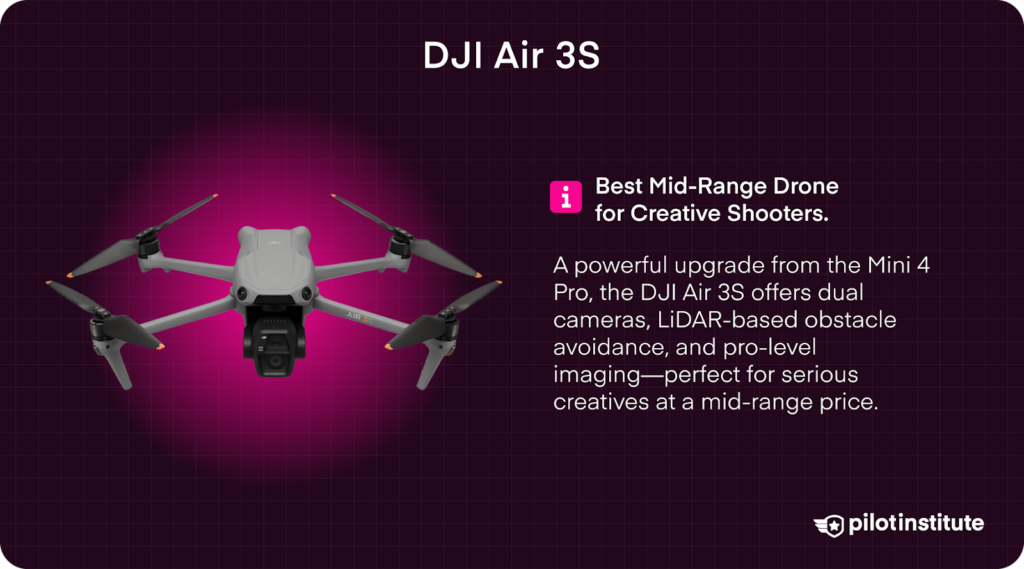
Best Mid-Range Drone for Creative Shooters
The DJI Air 3S is a great step up from the Mini 4 Pro. It features impressive upgrades compared to the Air 2S, like LiDAR obstacle avoidance features and a dual camera design. Still, it’s affordable, making the DJI Air 3S perfect for consumer pilots.
| Key Specs | Details |
| Max Flight Time | 45 Minutes |
| Camera Resolution | -Dual Camera System:-Wide: 50 MP-Medium Telephoto: 48 MP |
| Max Video Resolution | 1080p at 240 fps / 4K at 120 fps (Both Cameras) |
| Sensor Type | -Wide: 1” CMOS, f/1.8 Aperture-Medium Telephoto: 1/1.3” CMOS, f/2.8 Aperture |
| Obstacle Avoidance | Omnidirectional with LiDAR |
| Transmission Range | 12.42 Miles (20 km) |
| Weight | 724 g |
| Flight Modes | FocusTrack, Hyperlapse, MasterShots, Waypoint Flight, QuickShots |
| Price | $1,109 ($1,599 for Fly More Combo Lite with DJI RC2) |
| Manufacturing Location | China |
Pros:
- Features a two-camera system for innovative range.
- 14 Stops of dynamic range for excellent low-light footage.
- 42 GB of onboard, internal storage.
- Impressive panorama mode for ultra-wide shots.
- Incredibly fast, at 47 mph (75.6 km/h).
- Precise obstacle detection using LiDAR, even in low-light environments.
Cons:
- Only 26.8 mph (12 m/s) wind resistance.
- Signal interference concerns make flying in urban areas difficult.
- Issues with shipping and customs–buyers have faced long shipping times and rejection of orders at customs.
- Security concerns limit use in federal government agencies.
3. DJI Mavic 4 Pro
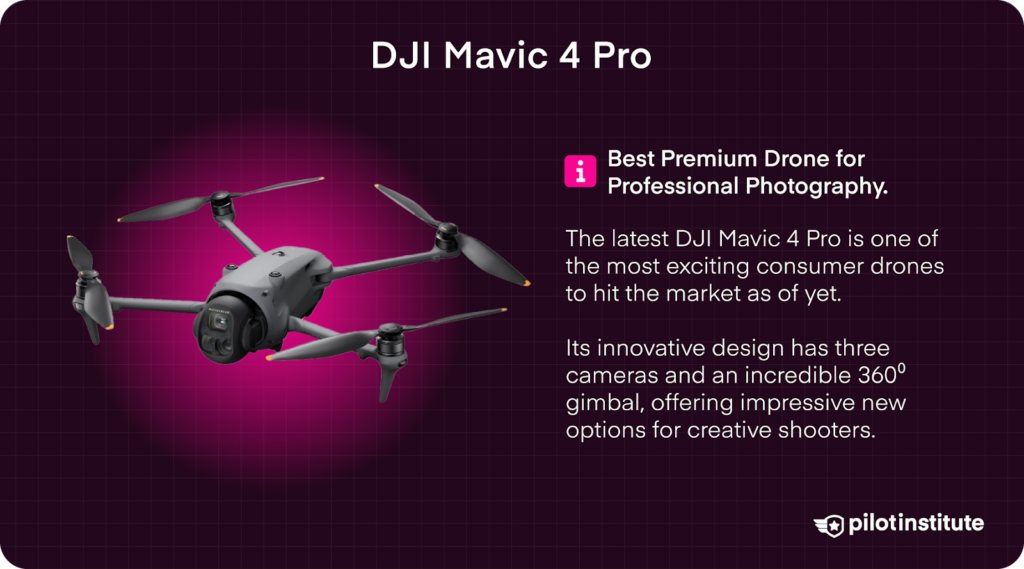
Best Premium Drone for Professional Photography
The latest DJI Mavic 4 Pro is one of the most exciting consumer drones to hit the market as of yet. Its innovative design has three cameras and an incredible 360⁰ gimbal, offering impressive new options for creative shooters. Yet, DJI is not selling in the US market, limiting its potential for American consumers.
| Key Specs | Details |
| Max Flight Time | 51 Minutes |
| Camera Resolution | 100 MP Hasselblad Main48 MP Medium Telephoto50 MP Standard Telephoto |
| Max Video Resolution | 4K at 120 fps, 6K at 60 fps |
| Sensor Type | Wide Hasselblad: 4/3” CMOS, f/2 LensMedium Telephoto: 1/1.3” CMOS, f/2.8 LensStandard Telephoto: 1/1.5” CMOS, f/2.8 Lens |
| Obstacle Avoidance | Nightscape Omnidirectional with LiDAR |
| Transmission Range | 18.6 Miles |
| Weight | 2.3 lbs (1,063 g) |
| Flight Modes | ActiveTrack, Hyperlapse, MasterShots, Panorama, Subject Focusing, QuickShots |
| Price | $2,699($3,549 Fly More Combo / $4,649 512 GB Creator Combo) |
| Manufacturing Location | China |
Pros:
- Three-camera design for diverse image capture.
- Ball-shaped 360⁰ Infinity Gimbal for wide movement range.
- Adjustable aperture for clean shots in low-light environments.
- Innovative 0.1-lux sensitivity designs improve performance for night flights, including a Nighttime RTH feature.
- 512GB version features a massive upgrade to internal storage and ALL-I encoding for rich video detail.
- High-res RAW, capable of image stacking.
- O4+ transmission reduces interference and improves signal performance.
- Quick Transfer for easy, wireless data transfer.
- 60 mph max speed.
Cons:
- Currently not sold by DJI in the US market, making purchase difficult.
- High price point and long wait times for those who do find it in the US market.
- Security concerns limit use in government agencies.
- High price point for average consumers.
4. Autel EVO II Pro V3
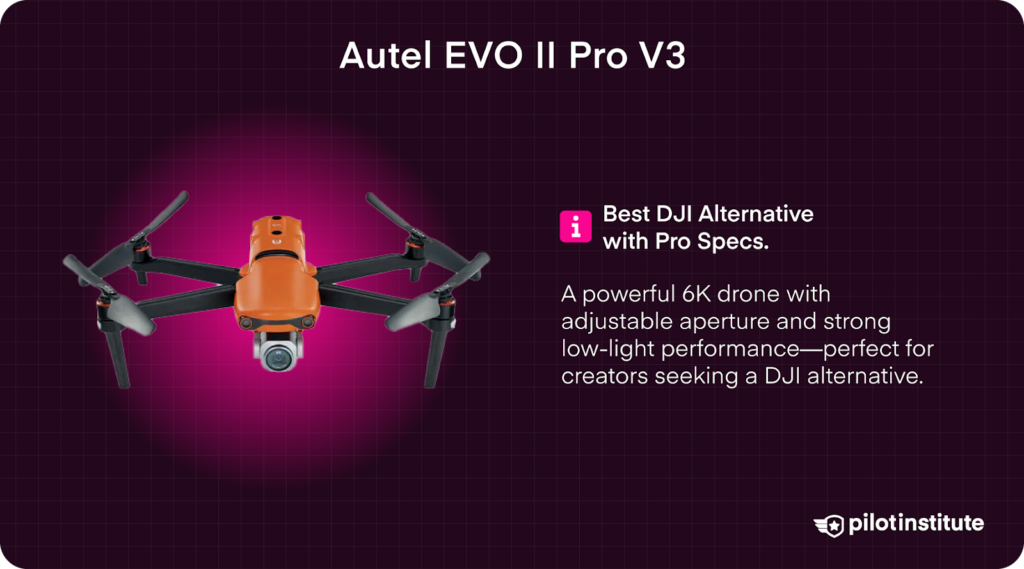
Best DJI Alternative with Pro Specs
Autel Robotics’ EVO II Pro V3 is a great DJI alternative. While it only has one camera, it offers 6K video capture and adjustable aperture for creative shots, even in low-light environments.
| Key Specs | Details |
| Max Flight Time | 40 Minutes |
| Camera Resolution | 20 MP |
| Max Video Resolution | 6K at 30 fps |
| Sensor Type | 1-inch CMOS |
| Obstacle Avoidance | 360⁰ Obstacle Avoidance |
| Transmission Range | 15 km (9.3 Miles) |
| Weight | 2.6 lbs (1,191 g) |
| Flight Modes | Dynamic Track, Hyperlapse, Mission Flight, Moon Algorithm, Parallel Track, Tripod Track, Waypoint Flights |
| Price | $1,899 (Spring Sale), $2,099 (Regular Price) |
| Manufacturing Location | China |
Pros:
- Adjustable aperture, ranging from f/2.8 to f/11.
- High ISO range.
- Capable of 12-bit DNG.
- 6.4” smart controller.
- Tri-band communication using 2.4 GHz, 5.8 GHz, and 900 MHz for reduced signal interference.
- 45MPH max speed for fast flights.
- Binocular vision camera for calculating depth maps, increasing landing accuracy.
Cons:
- Less range than comparable alternatives.
- 3-axis gimbal.
- Lower camera resolution than other options.
- Security concerns limit use in government agencies.
5. HoverAir X1 ProMax
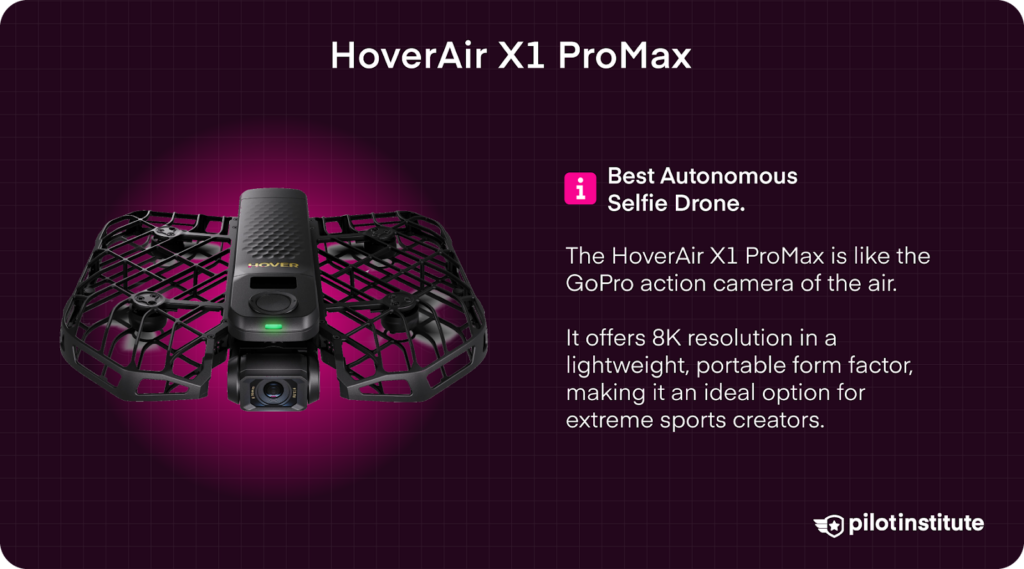
Best Autonomous Selfie Drone
The HoverAir X1 ProMax is like the GoPro action camera of the air. It offers 8K resolution in a lightweight, portable form factor, making it an ideal option for extreme sports creators.
| Key Specs | Details |
| Max Flight Time | 16 Minutes |
| Camera Resolution | 12 MP or 48 MP |
| Max Video Resolution | 8K at 30 fps |
| Sensor Type | 1/1.3” CMOS with 16mm Wide Lens |
| Obstacle Avoidance | Rear and Side Visual-Based Obstacle Avoidance |
| Transmission Range | 0.31 Miles (500 m) with Phone0.62 Miles (1 km) with Beacon Controller |
| Weight | 0.424 lbs (192.5 g) |
| Flight Modes | Cycle Mode, Dolly Zoom, Indoor Follow, Ski Mode |
| Price | $955 (Basic Combo)$1,292 (Cycling Combo)$1,282 (New Fly Joy Combo) |
| Manufacturing Location | China |
Pros:
- First 8K action camera, making it a massive improvement from the 2.7K resolution of the HoverAirX1.
- Super lightweight, foldable design.
- 64 GB of internal storage, with up to 1 TB SD card.
- Powerful AI processing.
- WiFi 6 capable of fast downloading.
- OmniTerrain design for extreme environments.
- Vertical video options.
- Under 250 g, so no need for FAA registration.
Cons:
- Shorter flight time than alternatives.
- Slower max speed, at 37 mph track bursts, with only 26 mph follow speeds.
- Security concerns limit use in government agencies.
6. Parrot Anafi USA
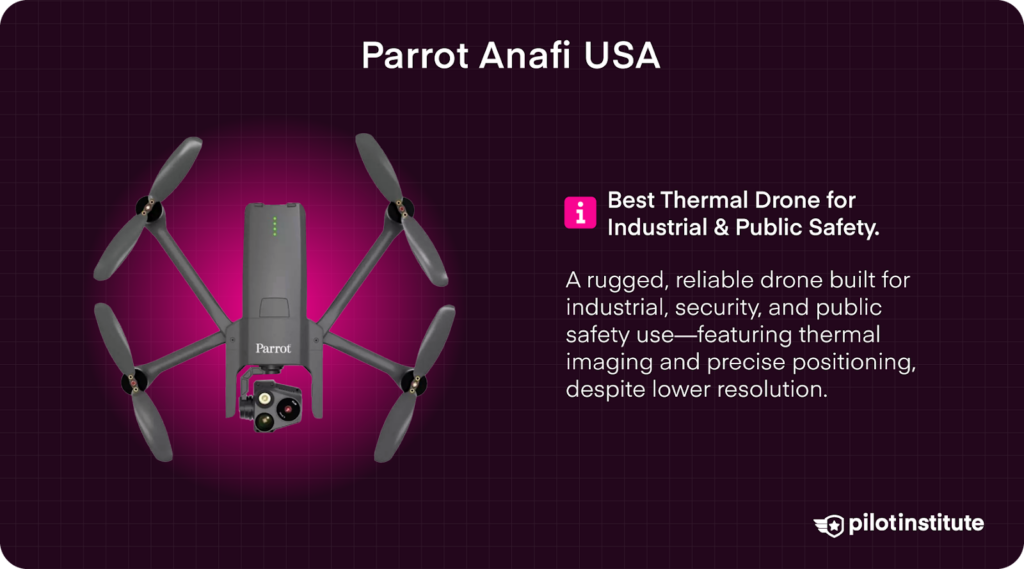
Best Thermal Drone for Industrial & Public Safety Use
The Parrot Anafi USA is a rugged, reliable drone perfect for industrial, security, and public safety applications. While it lacks high-resolution features, it packs a unique thermal camera and precise positioning capabilities.
| Key Specs | Details |
| Max Flight Time | 32 Minutes |
| Camera Resolution | Wide: 21 MPRectilinear: 16 MPFLIR BOSON Thermal: 320 × 256 |
| Max Video Resolution | 4K at 30 fps |
| Sensor Type | ½.4” CMOS |
| Obstacle Avoidance | 4 Stereo Cameras (One on Each Side) |
| Transmission Range | 1.25 Miles (2 km) |
| Weight | 1.1 lbs (500 g) |
| Flight Modes | Follow Me, Orbit, Waypoint |
| Price | $7,000 |
| Manufacturing Location | USA |
Pros:
- Three-camera design with a 33x digital zoom and thermal camera.
- High shutter speed for capturing subjects in motion.
- Super fast set up, making it flight-ready in seconds.
- Rapid charge batteries for quick charging turnaround.
- Impressive cybersecurity with data encryption.
- Made in the US and Blue sUAS approved, reducing security concerns.
- IP53 certified, making it dust and rain resistant.
- High wind resistance level at 32.8 mph (14.7 m/s).
- Can operate in extreme temperatures.
- Navigates using not only GPS, but also GLONASS and GALILEO for precise positioning.
Cons:
- Reduced image quality for video and stills.
- A 3-axis gimbal limits camera movement abilities.
- Only 32.8 mph max speed.
- High price tag.
7. DJI FPV

Best Entry-Level FPV Drone for Freestyle
The DJI FPV model is a great entry-level FPV drone that offers durability with speed. However, its camera quality is lacking compared to alternative models on this list.
| Key Specs | Details |
| Max Flight Time | 16 Minutes |
| Camera Resolution | 12 MP |
| Max Video Resolution | 4K at 60 fps |
| Sensor Type | ⅓.23” CMOS Sensor |
| Obstacle Avoidance | Forward and Downward Sensors (Normal Mode Only) |
| Transmission Range | 10.43 Miles (16.8 km) |
| Weight | 1.75 lbs (795 g) |
| Flight Modes | Normal, Sport, Manual, Image Roll Correction, Turtle Mode |
| Price | $679 (FPV Combo) / $1,500 (Explorer Combo) |
Pros:
- Super-wide camera angle at 150º field of view.
- Affordable, at well under $1K.
- The FPV combo comes with a drone, controller, and goggles.
- 60 mph speeds for racing and fast-paced shooting.
- Low latency minimizes video signal delays.
- Lightweight and nimble.
Cons:
- Short flight time, at only 20 minutes.
- Lower-quality camera resolution.
- Does not shoot RAW.
- No internal storage.
- Single-axis gimbal limits camera movement capabilities.
- Short battery life.
- Not sold by DJI in the US, forcing consumers to have to look to third-party retailers.
- Security concerns limit use in government agencies.
8. DJI Avata 2
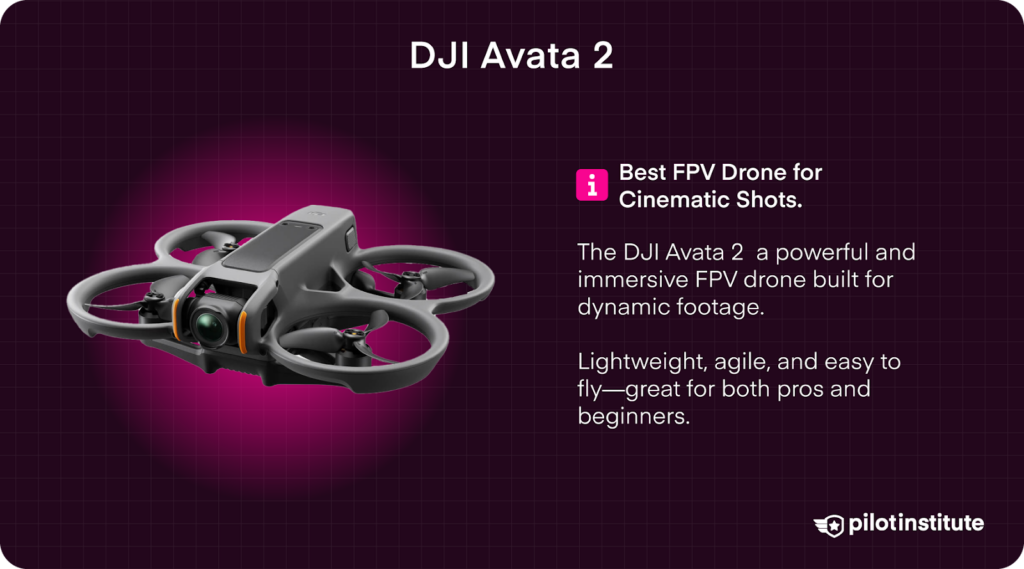
Best FPV Drone for Cinematic Shots
DJI’s Avata 2 is a top-tier FPV option, combining speed, agility, and impressive camera qualities. With its lightweight but sturdy design, the Avata 2 is a great option for both beginners and advanced FPV pilots.
| Key Specs | Details |
| Max Flight Time | 23 Minutes |
| Camera Resolution | 48 MP |
| Max Video Resolution | 4K at 60 fps |
| Sensor Type | 1/1.13” CMOS Sensor |
| Obstacle Avoidance | Downward, Binocular Fisheye Sensors with Infrared Enhancement |
| Transmission Range | 6.2 Miles (10 km) |
| Weight | 0.83 lbs (377 g) |
| Flight Modes | One-Push Power Loop, One-Push Flip, One-Push Roll |
| Price | $549 ($829 with Goggles Integra) |
| Manufacturing Location | China |
Pros:
- Incredibly immersive flight experience thanks to the DJI Goggles 3 with an OLED high definition display and the DJI RC Motion 3 controller.
- Easy-to-use acrobatic capabilities with a simple one-push design.
- 360º roll for incredibly dynamic shots.
- Incredibly fast at 60.4 mph max speed.
- Propeller guards and emergency braking for increased protection.
- Low transmission latency with O4 video transmission.
- Rock Steady 2.10 EIS enhances stabilization, even in indoor environments.
- 46 GB internal storage.
- Shots in D-Log for accurate color grading in post production.
- Incredible signal range at over 6 miles.
Cons:
- Low flight time compared to other models.
- Low camera resolution and lack of RAW shooting.
- Issues with shipping and customs–buyers have faced long shipping times and rejection of orders at customs.
- Security concerns limit use in government agencies.
9. DJI Neo
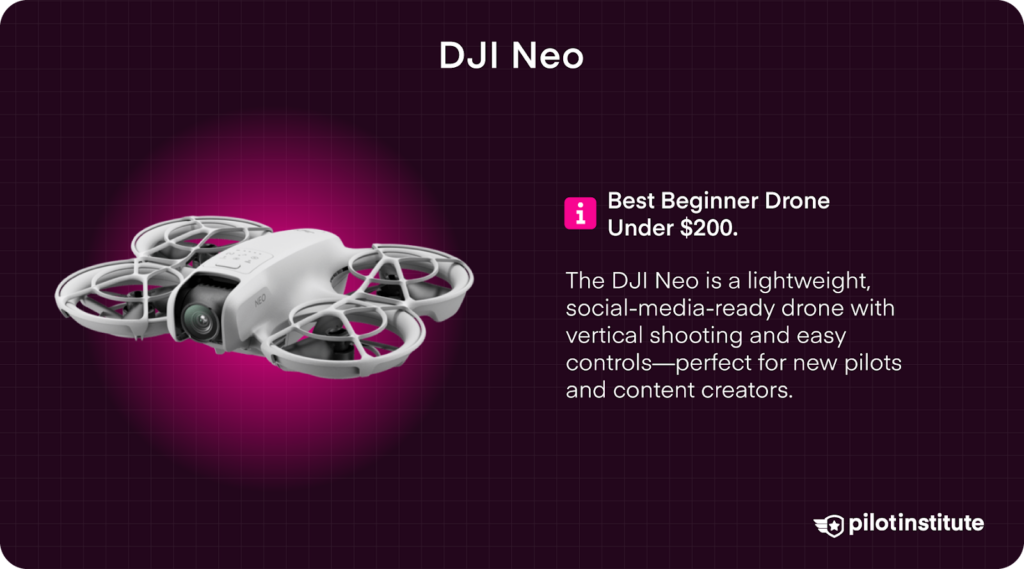
Best Beginner Drone Under $200
The DJI Neo’s vertical shooting capabilities, Palm Takeoff, and built-in Glamour Effects make it a perfect option for vlogging and social media content creation. With the DJI Neo price point below $200, many users are willing to look past the limited camera quality.
| Key Specs | Details |
| Max Flight Time | 18 Minutes (17 Minutes with Propeller Guards) |
| Camera Resolution | 12 MP |
| Max Video Resolution | 4K at 30 fps |
| Sensor Type | ½” Image Sensor |
| Obstacle Avoidance | N/A |
| Transmission Range | 6.2 Miles (10 km) |
| Weight | 0.297 lbs (135 g) |
| Flight Modes | Subject Track, QuickShots |
| Price | $199 |
| Manufacturing Location | China |
Pros:
- Lightweight and compact design for on-the-go adventures.
- 1080p vertical shooting options for social media content.
- Horizon Balancing software increases stabilization and keeps shots balanced.
- Records audio when paired with a DJI Mic.
- Built-in smoothing using Glamour Effects.
- 22 GB of internal storage for up to 40 minutes of filming without the need for SD cards..
- Multiple control options, including voice control.
- Can be flown without an RC controller, using a phone app.
- Palm Takeoff for easy launch in tight environments.
- Impressive gear protection with full-coverage propeller guards.
- Extremely affordable, at under $200.
- Under 250 g, so no need for FAA registration.
Cons:
- Reduced camera quality.
- Shorter flight times.
- A single-axis gimbal limits camera mobility and movement.
- Reduced wind resistance, at only level 4.
- No obstacle avoidance
- Palm Control does not function in low-light environments.
- Issues with shipping and customs–buyers have faced long shipping times and rejection of orders at customs.
- Security concerns limit use in government agencies.
10. Holy Stone HS720E
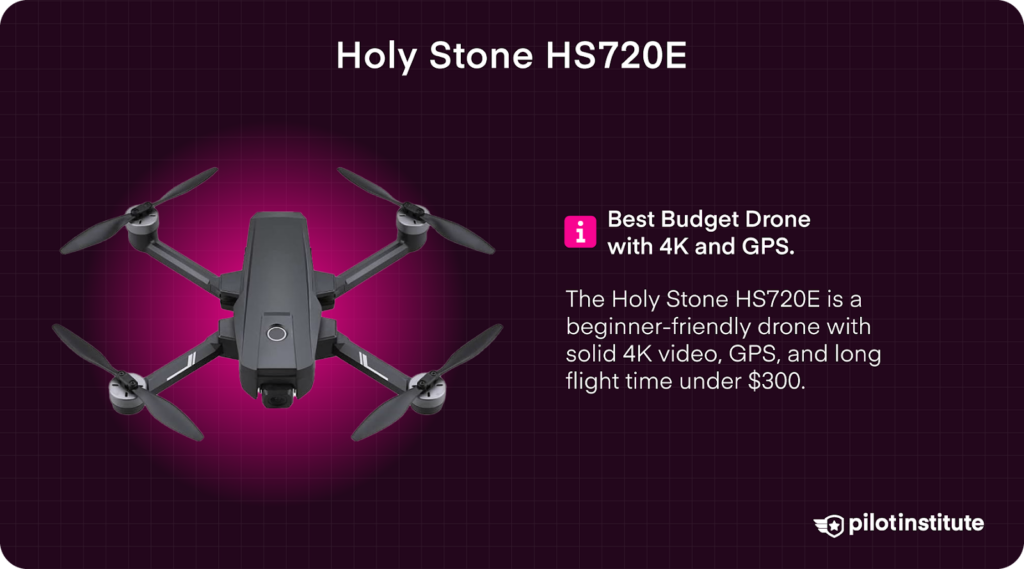
Best Budget Drone with 4K and GPS
Holy Stone’s HS720 E is an interesting alternative for fast-paced shooting environments. The HS720 E is a user-friendly drone is great for beginners on a budget.
| Key Specs | Details |
| Max Flight Time | 46 Minutes |
| Camera Resolution | 12 MP |
| Max Video Resolution | 4K at 30 fps |
| Sensor Type | Sony Sensor with Anti-Shake Technology |
| Obstacle Avoidance | N/A |
| Transmission Range | 1,640 Feet |
| Weight | 1.09 lbs (495 g) |
| Flight Modes | Follow Me, Point of Interest, Tap Fly |
| Price | $299 (Sale) / $409 (Regular) |
| Manufacturing Location | China |
Pros:
- Impressive flight time for the price point.
- Electronic image stabilization enhances 4K video.
- Ultra-wide lens at 130º FOV.
- Uses GPS and GLONASS for precise positioning.
- Lightweight, collapsible design for ultimate portability.
- Brushless motor for higher efficiency and a longer lifespan.
Cons:
- Reduced camera resolution with low MP and fps.
- Short transmission range limits it’s ability to explore.
- Can only accommodate a 128 GB SD card.
- Lacks a mechanical gimbal.
- Lack of obstacle avoidance increases the risk of crashes and accidents.
- Security concerns limit use in government agencies.
11. EXO Scout
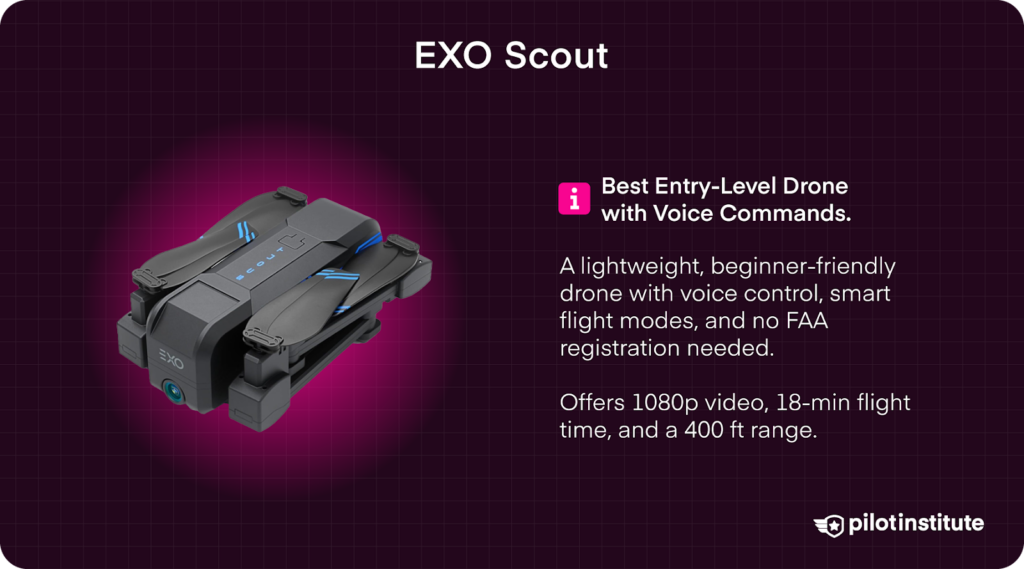
Best Entry-Level Drone with Voice Commands
The EXO Scout is a basic budget option for entry-level pilots. While it only shoots 1080p, it is lightweight and portable for those on the go.
| Key Specs | Details |
| Max Flight Time | 18 Minutes |
| Camera Resolution | 6 MP |
| Max Video Resolution | 1080p |
| Obstacle Avoidance | Downward Sensors |
| Transmission Range | 400 ft |
| Weight | 0.54 lbs (245 g) |
| Flight Modes | Pin Fly, Virtual Reality, Follow Me |
| Price | $129.99 (Single Battery) / $151 (Two Batteries) |
| Manufacturing Location | China |
Pros:
- Incredibly affordable, making it great for beginners.
- Intelligent flight modes, even in the low price point.
- Controllable with voice commands.
- Lightweight and foldable for great portability.
- Under 250 g, so no need for FAA registration.
Cons:
- Low resolution still and video.
- Single-axis gimbal reduces camera mobility and movement.
- Limited flight times reduce range.
- Very low wind resistance, at only 3 mph.
- Lacks GPS positioning.
- No return to home function.
- Security concerns limit use in government agencies.
How to Decide Which Drone to Buy
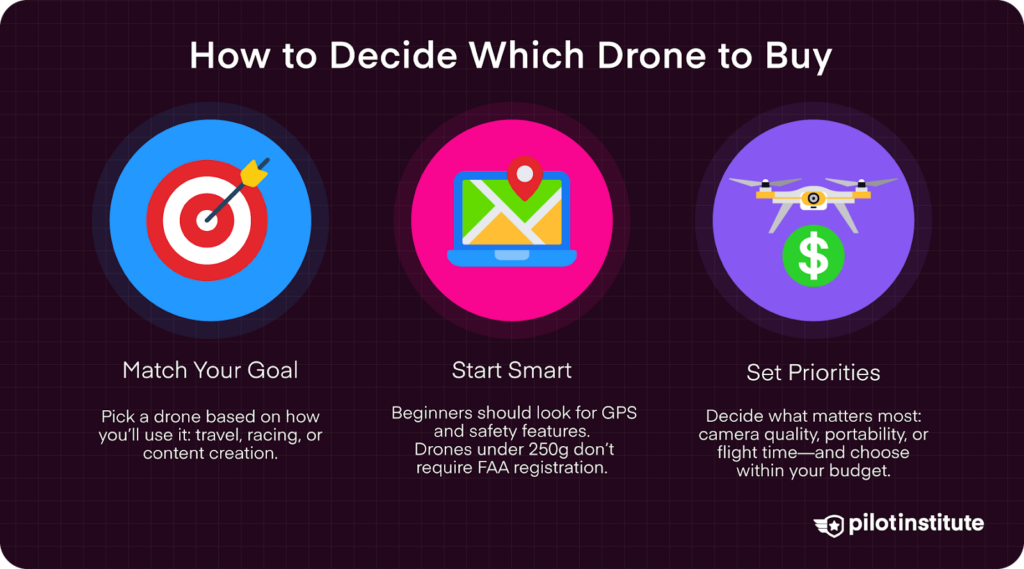
Define Your Primary Use Case
Whether you are capturing incredible travel locations all over the globe, racing through obstacle courses, or inspecting infrastructure, each use case demands different features and capabilities. Think about where and how you will be flying to best prioritize the specs you need the most.
For adrenaline-pumping acro-flying, look for lightweight frames and powerful motors. DJI’s Avata 2 may be the best option for you.
Looking to up your social media game? Focus on vertical video shooting and automated flight modes that make capturing selfies a breeze. The HoverAirX1 ProMax, DJI Mini 4 Pro or DJI’s Neo are just what you might be looking for.
Set Your Budget Range
Next, tally up your budget. Typical price breaks range from under $300, $500 to $1,000, and $1,500 and over.
Just remember, cost savings tend to result in lower resolution cameras and less flight time.
If you have a few bucks to spare, higher-tier drone options offer impressive camera capabilities that can help your content really stand out.
Think About Flight Time and Battery Life
Another thing to consider is just how important battery life is, especially for creators and travelers. Not having to be tied to a charging cord all the time really opens up opportunities, and thus is worth a bit more of an investment.
Meanwhile, if speed is your priority, you may want to choose performance over battery life.
Camera Quality vs Portability
There is, unfortunately, a trade-off when looking at image quality and portability. While smaller drones, like DJI’s Mini 4 Pro or Neo, are easier to travel with, they tend to have smaller camera sensors.
Meanwhile, larger drones may be bulky–but they pack impressive cameras for stellar content.
How do you travel? Backpackers on a budget may be willing to sacrifice a bit of camera quality to get more action, candid shots. For those who stay more local or don’t mind a few extra pounds to get the best shot possible, the DJI Air 3S is a great balance for portability without sacrificing too much camera capability.
Do You Want Beginner-Friendly Features?
Features like GPS lock, return to home functions, and obstacle avoidance are key for new pilots. They offer safety features that protect your investment while giving you the space to learn to fly.
Newbies may also benefit from propeller guards when looking to dabble in the FPV world.
Regulations: Do You Need to Register It?
Remember, any drones over 250 g must be registered with the FAA or other global equivalent. The fact that the DJI Mini 4 Pro, DJI Neo, and EXO Scout fit right under that limit makes them top options for those wishing to avoid paperwork and bureaucracy and just get straight to flying.
DJI Drone Considerations
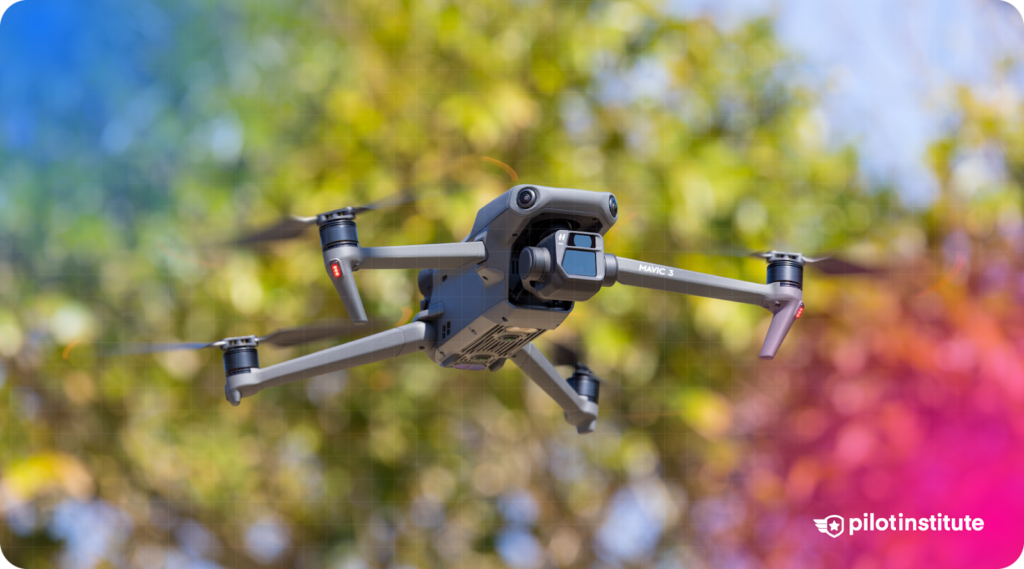
Why DJI Dominates the Drone Market
DJI dominates 70% of the global market share for drone sales, thanks to the brand’s commitment to innovation and continuous technological advancement.
Their drones are both user-friendly and full of advanced features, making them top options for a variety of use cases.
Additionally, DJI’s large-scale production allows their drone models to offer impressive features and performance–at affordable price points.
Key Differences Between DJI Models
Our top choice, the Mini 4 Pro, is a perfect blend of portability and feature-rich innovation.
For more powerful cameras and high-resolution video production without sacrificing portability, the DJI Air 3S is a better choice.
The next step up is the Mavic Pro 4. While significantly bulkier and hard to acquire here in the US, the Mavic Pro 4 is the top of the consumer food chain when it comes to innovative camera features.
Want to dip into FPV flying? DJI’s FPV model is an affordable and rugged choice. However, like the Mavic 4 Pro, it is hard to get for American consumers.
The Avata 2 is pricier, but easier to acquire and rich with features that make it the perfect option for a blend of FPV and content creation.
DJI Geofencing: What You Should Know
While DJI was long known for its geofencing technology that hindered flight in high-risk and sensitive areas, the brand recently took a turn in the opposite direction, disabling geofencing altogether.
Currently, DJI has removed geofencing restrictions, so concerns about locked areas are largely outdated.
What’s Going On With the DJI Ban in the U.S.?
DJI remains available to U.S. consumers, but that could change soon. The 2025 National Defense Authorization Act may trigger a DJI ban—potentially as early as June 2025.
Additionally, ongoing issues with tariffs make shipping Chinese-made drones like DJI models difficult. Many have reported issues with DJI drones getting stuck at the border, with customs even returning drones and forcing refunds.
Keep this in mind when shopping–your favorite drone may not be worth the wait at the current moment.
Alternatives to DJI: Are They Worth It?
Want to avoid the headache of navigating the complex issues surrounding DJI? Some impressive alternatives look better than ever.
Autel Robotics offers high-performance drones with specs very similar to many DJI models. They are known for their robust build quality and user-friendly interfaces. But since they’re also made in China, they face the same security concerns and customs delays.
Want something without the headache of foreign manufacturers altogether? Parrot USA offers drones made in the US. emphasizing open-source platforms and enhanced cybersecurity. However, these may be a bit more advanced (and pricey) for the average consumer pilot.
For those looking for lightweight, budget options, the EXO Scout is also built in the US. It’s a great entry-level option, without the need for FAA registration.
Conclusion
Choosing the right consumer drone means looking past all the flashy marketing and getting to the real meat of each model’s specs.
It is important to think of your specific use case to narrow down which specs are best for you.
Knowing your budget is also important. While splurging on innovative features is great for the budding professional, hobbyists may want to keep their investments manageable.
Keep our handy comparison table open in your search for the perfect consumer drone!
Pilot Institute also offers a wide variety of drone courses, with free and paid pilot training and individual model deep dives.
Want to fly drones professionally? Explore our commercial drone training courses to get certified and start your drone career.
